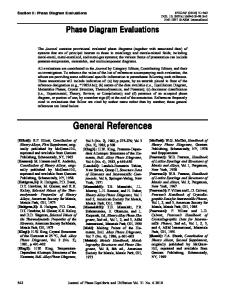Reevaluation of the Fe-Mn phase diagram
- PDF / 190,291 Bytes
- 9 Pages / 612 x 792 pts (letter) Page_size
- 103 Downloads / 294 Views
Section I: Basic and Applied Research
Reevaluation of the Fe-Mn Phase Diagram V.T. Witusiewicz, F. Sommer, and E.J. Mittemeijer
(Submitted December 9, 2003; in revised form May 24, 2004) New results for the enthalpy of mixing of liquid Fe-Mn alloys, the enthalpy of formation of ␥-Fe-Mn solid solutions and the heat capacity of ␣-Fe-Mn and ␥-Fe-Mn alloys obtained by isoperibolic calorimetry and differential thermal analysis (DTA) measurements have been used for the reassessment of the molar Gibbs energy of the various phases of the Fe-Mn system. Experimental information about martensitic transformation temperatures in Fe-Mn alloys published recently was incorporated in the updating of the occurring metastable equilibria. The present reevaluation results in a good fit with all available experimental data and is compared with the results of previous assessments.
1. Introduction New experimental data for the enthalpy of formation of liquid and solid alloys and the heat capacity of solid ␣ and ␥-Fe-Mn alloys, have been published recently by the present authors [2003Wit]. Such data are crucial for the quantitative description the Fe-Mn phase diagram and for the assessment of the chemical driving forces of technically important solid-state transformations such as the fcc-A1(austenite)/ bcc-A2(ferrite) and fcc-A1/cph-A3 martensitic phase transformations. The thermodynamic properties given in the existing CALPHAD descriptions [1987Hua, 1989Hua, 1989Lee, 1998COS] were updated in the present work on the basis of new experimental information on the enthalpy of mixing of liquid Fe-Mn alloys, the enthalpy of formation of ␥-Fe-Mn solid solutions, the heat capacity of solid ␣-FeMn and ␥-Fe-Mn alloys provided by [2002Li, 2003Wit], and the martensitic transformation temperatures given by [1995Cot, 1998Cot]. To this end the least squares optimization module in Thermo-Calc called Parrot, as developed by Janson [1985Sun] was applied.
2003Wit] and the activity data of manganese in the liquid and solid alloys [1955San, 1961Bun, 1966Sch, 1967Sch, 1973Ste, 1974Ben, 1979Sud, 1984Jac, 1987Hay] were used. Heat capacity data and enthalpy of transformation data of both ␣-Fe-Mn and ␥-Fe-Mn alloys were adopted from the most recent investigations of [2002Li] and [2003Wit]. The composition variations of the Curie and Néel temperatures of the phases were described by polynomials using the appropriate experimental data of [1966Ume, 1967Ish, 1967Has, 1971End, 2002Li, 2003Wit].
3. Thermodynamic Modeling The Fe-Mn system contains the following solution phases [1956Hel, 1998COS]: liquid, bcc-A2, bcc-A12, cubA13 and fcc-A1; a metastable cph-A3 phase has been also identified. All these phases can be described as substitutional solutions using the Redlich-Kister polynomial description for the corresponding Gibbs energies, as in previous assessments [1987Hua, 1989Hua, 1989Lee]. The molar Gibbs free energy of each phase () listed can be expressed as:
2. Experimental Data As a basis for the assessment the main information on the phase equilibria was princ
Data Loading...











